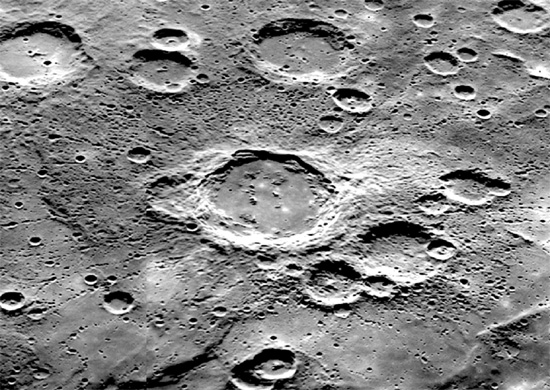|

Firdousi, a rampart crater (center)
on Mercury, illustrates electric arc
erosion. Credit: NASA/Johns Hopkins
University Applied Physics
Laboratory/Carnegie Institution of
Washington
The Electrical Etching of
Mercury
Sep
09, 2011
The MESSENGER space probe is
confirming the Electric Universe
theory.
MESSENGER entered orbit around
Mercury on March 17, 2011 after
traveling nearly eight billion
kilometers. Since that time, it has
sent hundreds of close-up images of
the surface, revealing features and
topography that assure Mercury's
kinship with the Solar System's
other celestial bodies: its surface
is pitted, gouged, punctured, and
grooved in ways so like its sisters
and brothers that telling it apart
from some of them would be
difficult.
Past electrical activity on
Mercury is evident in several
locations around the planet. Indeed,
the entire planet could be said to
exhibit nothing but electrical
effects. The
etched furrows radiating
outward from some craters, such as
Firdousi, above, denote
the path of untold numbers of
electric filaments as they danced a
fiery dance across the surface. On
Earth, those filaments would have
been the largest lightning strikes
ever witnessed.
A landscape such as the one
surrounding Firdousi would be
difficult to reproduce in the
laboratory, unless electricity were
brought into the picture. Not the
electricity needed to operate a
compressed air gun firing hypersonic
projectiles, but that needed to act
as a high voltage discharge.
In an experiment at Vemasat
Laboratories, Dr. C. J. Ransom
created the same kind of etched
furrow by shocking a thin layer of
magnesium silicate with a 120
milliamp, 12,000 volt discharge for
five seconds. He created
radial gouges on a small
scale equivalent to Mercury at the
large scale. As pointed out in
previous Pictures of the Day, Nobel
Laureate Hannes Alfvén thought that
electrical (plasma) phenomena could
be scaleable by as much as 14 orders
of magnitude.
Since an electric arc is composed
of rotating filaments, if
electricity were involved in
Mercury's evolution, it would have
manifested in many ways. One of
those ways would be to act like a
plasma "drill bit," cutting steep
crater sidewalls, while sometimes
leaving a “pinched up” mound in the
center. Multiple filaments would cut
one crater within another, often
with one or more craters on the
rims. Firdousi, among dozens of
other
large craters on Mercury,
conforms to that insight.
What is most remarkable about
Mercury and other members of the
Solar System are the numerous crater
chains that abound throughout the
population. From
Phobos to Phoebe; from
Mars to Miranda, planets and moons
are
pocked with holes that
run in
long lines, sometimes for
hundreds of kilometers. The common
explanation for them is that a
string of meteoroids impacted one
after another, one behind the other.
The necessary coincidence for that
effect notwithstanding, the absence
of distortion in adjoining crater
walls calls the theory into
question. Add to that the twists,
turns, loops, and braids that can be
seen in many of them and the idea
that rocks falling from space caused
these features falls apart.
Anyone who has made an electric
arc device called a "Jacob's Ladder"
knows how the line of craters could
have formed. A Jacob's ladder is
constructed by placing a stiff
copper wire on each standoff of a
neon sign transformer and then
bending them in toward each other
until they form an ever-widening "V"
from bottom to top. When the current
is turned on, an electric arc begins
at the lowest level of the V and
then rises up to the top, growing
longer across the widening gap until
it disconnects with a snap, only to
immediately begin again. If a piece
of paper is held between the two
limbs of the V while the electric
arc travels upward, a row of
pinholes will be found burned
lengthwise into the paper.
Electric arcs traveling across a
conductive medium vary in strength
from millisecond to millisecond, so
they burn chains of craters instead
of smooth channels. In fact, the
"smooth" channels seen on many
objects are actually crater chains
that are packed so close together
that they can no longer be
distinguished.
There are
more examples from MESSENGER
that reveal Mercury's catastrophic
past. It is certain that additional
evidence supporting the new Electric
Universe paradigm will come to
light.
Stephen
Smith
 New
DVD New
DVD
The Lightning-Scarred
Planet Mars
A video documentary that could
change everything you thought you
knew about ancient times and
symbols. In this second episode of
Symbols of an Alien Sky, David
Talbott takes the viewer on an
odyssey across the surface of Mars.
Exploring feature after feature of
the planet, he finds that only
electric arcs could produce the
observed patterns. The high
resolution images reveal massive
channels and gouges, great mounds,
and crater chains, none finding an
explanation in traditional geology,
but all matching the scars from
electric discharge experiments in
the laboratory. (Approximately 85
minutes)
Video Selections
Order Link
|





 New
DVD
New
DVD

